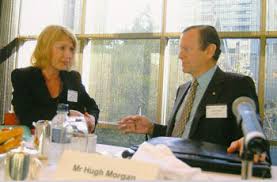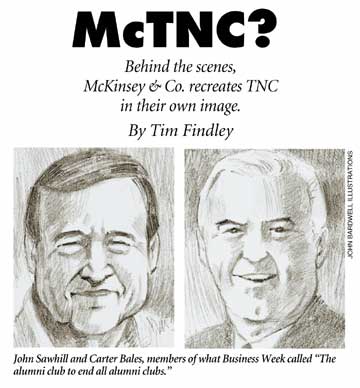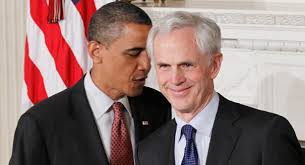The existence of a revolving door can give rise to a lack of independence on the part of career environmentalists. There are numerous examples of activists who now work for the industries they once opposed. They are attractive to corporations and industry associations who wish to present an environmentally benign image to the public because they have a reputation for caring for the environment derived from their  previous positions in environmental groups and so they are often assumed to have environmental interests at heart despite their change of employment.
previous positions in environmental groups and so they are often assumed to have environmental interests at heart despite their change of employment.
Environmental activists can parlay their green credentials and experience in the environmental movement into a lucrative consulting career, hiring themselves out to clients wishing to greenwash their image, oppose environmental groups, or undermine environmental measures being proposed by governments. For industry, "the professional wing of environmentalism" can provide "training for high-level industry jobs".
Former environmental activists are especially attractive to lobbying and public relations firms because of their inside knowledge of how environmentalists think and operate as well as their expertise in environmental campaigning, which requires an understanding or how the public relates to environmental issues. When PR giant Burson-Marsteller hired the former chairman of Friends of the Earth in the UK, Des Wilson, as director of public affairs and crisis management he was “reckoned to be one of the highest paid people in PR”. He subsequently became a director of corporate and public affairs for BAA.
Stauber and Rampton point out that hiring those who are effective is a “crude but effective way to derail potentially meddlesome activists”. There are numerous examples of such activists who now work for industry. For example Carol Tucker Foreman, once executive director of the Consumer Federation of America, now works for Monsanto. Candy Lightner, who began Mothers Against Drunk Drivers after her daughter was killed by a drunk driver, is now a lobbyist for the American Beverage Institute, a liquor industry trade group.
In particular, high profile environmentalists have valuable green credentials that industry interests can utilise in their green washing efforts. For example, Tricia  Caswell (pictured) was executive director of the Australian Conservation Foundation (ACF) before she became chief executive of the Victorian Association of Forest Industries, the main lobby group for logging interests. She also became a founding director of the PNG Sustainable Development Program Company established by BHP (after BHP gave up its share of the Ok Tedi Mine in return for guarantees it would not be sued for the environmental damage it had caused) and a member of the "Global Assurance Group overseeing the Global Mining Initiative auspiced by The World Business Council for Sustainable Development sponsored by 30 of the world's largest mining companies (2000–2002)".
Caswell (pictured) was executive director of the Australian Conservation Foundation (ACF) before she became chief executive of the Victorian Association of Forest Industries, the main lobby group for logging interests. She also became a founding director of the PNG Sustainable Development Program Company established by BHP (after BHP gave up its share of the Ok Tedi Mine in return for guarantees it would not be sued for the environmental damage it had caused) and a member of the "Global Assurance Group overseeing the Global Mining Initiative auspiced by The World Business Council for Sustainable Development sponsored by 30 of the world's largest mining companies (2000–2002)".
 Jay Hair (pictured), the head of the National Wildlife Federation in the US, went on to work for "Plum Creek Timber Company, a logging outfit so rapacious that a Republican congressman deemed it the 'Darth Vader of the timber industry'." He later worked with the World Mining Congress and the World Bank as well as "fronting for the likes of Newmont Gold, one of the industry's biggest and nastiest outfits".
Jay Hair (pictured), the head of the National Wildlife Federation in the US, went on to work for "Plum Creek Timber Company, a logging outfit so rapacious that a Republican congressman deemed it the 'Darth Vader of the timber industry'." He later worked with the World Mining Congress and the World Bank as well as "fronting for the likes of Newmont Gold, one of the industry's biggest and nastiest outfits".
His last big project was lobbying for the completion of a giant dam in Chile. This monument of environmental destruction dwarfs even Glen Canyon dam and will destroy nearly nearly a 500-miles of river, hundreds of villages, drown thousands of acres of forests and forcibly displace indigenous people.
Tom Burke, a Friends of the Earth director went on to work for the mining company Rio Tinto, and Jonathon Porritt, former head of Friends of the Earth in the UK, went on to work for the UK government.
The institutionalisation of large environmental groups has also seen an increase in the number of industry executives joining environmental groups at the top level. For example, in 2004 WWF-Australia appointed Greg Bourne as their CEO. Bourne’s previous career had been with oil company, BP, including as Regional President of BP Australasia including two years as policy adviser to Margaret Thatcher. Bourne had defended BP's "plans to drill for oil in the Arctic National Wildlife Refuge".
Mike Russill was president and CEO of WWF Canada (2004-2008) after a career that included "thirty-years in the private energy sector, with Shell Canada Inc., Petro-Canada Inc." and as Vice-President of Suncor Inc. He also served as a board director of Nature Conservancy of Canada, Pioneer Petroleum Limited, UPI Petroleum.
Few things make a corporate executive or lawyer look greener than a seat on the board of an environmental organization. A 1990 survey of seven mainstream environmental boards conducted by the Multnational Monitor found 67 individuals who also served as chair, CEO, president, consultant or director of 92 major coporations.
The National Wildlife Federation in the US "has invited corporate chieftains, including Dean Buntrock of Waste Management Inc., to join its board of directors. It's the favorite charity of John Denver and big oil companies, including Arco, Chevron and Mobil."
 John Sawhill was a former deputy secretary of the Department of Energy in the Carter administration and a director at management consultants McKinsey before he became head of The Nature Conservancy (TNC) in 1990. He subsequently returned to be a director of McKinsey’s Washington DC office until his death in 2000.
John Sawhill was a former deputy secretary of the Department of Energy in the Carter administration and a director at management consultants McKinsey before he became head of The Nature Conservancy (TNC) in 1990. He subsequently returned to be a director of McKinsey’s Washington DC office until his death in 2000.
Some environmental groups that depend on corporate funds are particularly amenable to the involvement of current corporate executives in their operations. On occasion corporations lend executives to The Nature Conservancy (TNC), for example, as in the case of Georgia Power which loaned Gordon Van Mol, from its External Affairs Department, to be a member of TNC’s development team for a year.
There is also a revolving door between environmental groups and government. For example William Reilly was head of the World Wildlife Fund (WWF) before being appointed to head the US EPA (1989-93). Afterwards he returned to the WWF for a short time, later becoming a director at oil company, ConocoPhillips and advisor to TPG Capital, an international investment firm.
In part a revolving door with government was the consequence of the way mainstream environmental groups became more institutionalised and involved in the maintenance of government policy systems. As early as the late 1970s key environmental leaders from the Environmental Defense Fund (EDF) and Natural Reousrces Defense Council (NRDC) were appointed to the Carter administration and state resource agencies.
 One of the founders of the NRDC was John Bryson (pictured with the president), who later became head of the California Public Utilities Commission (CPUC) and then CEO of Edison International. He was also "founder and cochair of the Pacific Council on International Policy, founded in 1995 in partnership with the Council on Foreign Relations, the promotional arm of the ruling elite in the U.S" and most recently US Secretary of Commerce 2011-12, a nomination endorsed by the Chamber of Commerce.
One of the founders of the NRDC was John Bryson (pictured with the president), who later became head of the California Public Utilities Commission (CPUC) and then CEO of Edison International. He was also "founder and cochair of the Pacific Council on International Policy, founded in 1995 in partnership with the Council on Foreign Relations, the promotional arm of the ruling elite in the U.S" and most recently US Secretary of Commerce 2011-12, a nomination endorsed by the Chamber of Commerce.
The NRDC still operates a revolving door with government policy makers:
...it would be hard to find a group with more connections in state or federal agencies than NRDC, and staffers move frequently between the organization and the public sector.
NRDC alums include U.S. EPA acting Assistant Administrator for Water Nancy Stoner; Michael Goo, now in a senior policy post at the Energy Department after stints in EPA's policyoffice and on Capitol Hill; and Mary Nichols, who heads the California Air Resources Board. There are numerous others.
In Australia Phillip Toyne was director of the Australian Conservation Foundation (ACF) from 1986 to 1992 and then employed by the federal environment minister in 1994. Peter Garrett (pictured), lead singer for Midnight Oil, was president of ACF before becoming an ALP member of parliament and then environment minister.